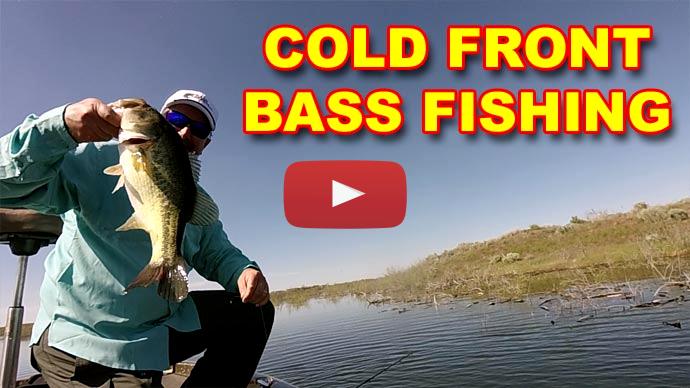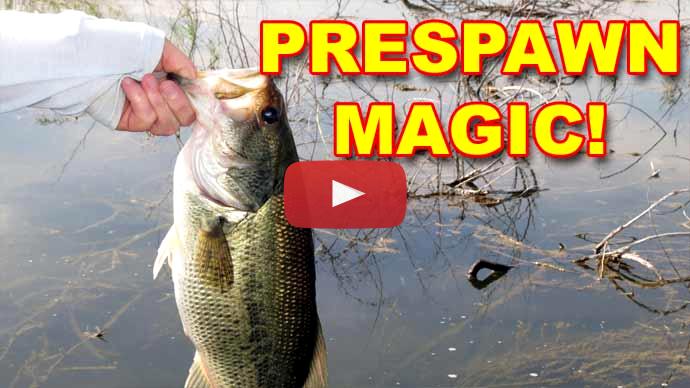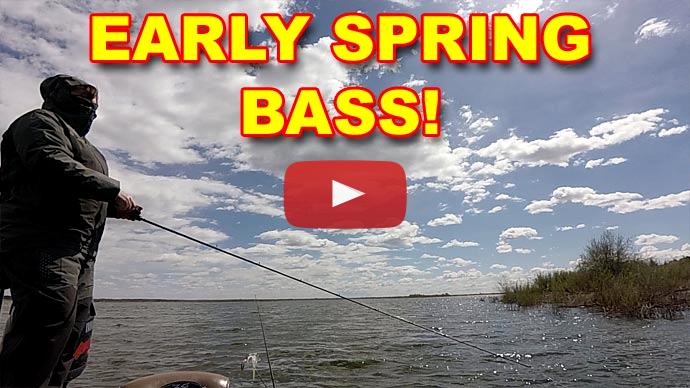Keri: Here we go. Better one?
Glenn: Yeah. I bounced right off a rock. Soon as it hit the rock, bang. Smacked it as soon as it ricocheted off the rock. Here we go.
Hey, folks. Glenn May here with BassResource.com, and today, I'm going to talk about prespawn bass fishing. You know, during this time of year, the fish are on the move. They're in transition mode, they're moving from deep to shallow and they can be anywhere, they keep changing every day, and so what you need to do is use search baits. It's critical to have some search baits with you to be able to connect with these fish any time when you go fishing to try to figure out where they're at.
But it can be confusing, like what bait to use, there's all kinds. Some days, it seems like they're biting anything, and the other days, they're not going to bite anything at all, plus you've got different water clarities and, you know, you've got rivers and lakes and impoundments and different things, it can be really confusing.
Well, guess what? It really isn't. I'm going to tell you the three main baits that I use for search baits during the prespawn and how I select those colors to help you out narrow down your choices. So, let's get right into it.
The first one I like to use is a rattling lipless crankbait. These are great to use because you can cover a lot of water quickly, and you can cover all depths. So, for example, early in the spring when the fish are really deep, they're in 20 feet deep or deeper water, they'll stage up in those areas that are at the entrances to bays and coves. So, I target those points, those steep points, steep banks, bluffs and creek channels, those are the things I like to target and like to parallel them with this bait.
One of the things you do when they're this deep is, you know, the bite isn't that strong. It's still cold out, the temperatures are...the water temperatures are in the upper 40s, mid 40s, so the fish aren't going to chase the bait very far. So, here, what you want to do is keep the bait down on the bottom. I'm using a 3/4 ounce bait to get it down there, and instead of just reeling it like you would a crankbait, I hold it to the side and I just like to pull it along. Give it a pause, reel it back up, and then it's a side sweep, just a side pull, that's all you want to do.
So, what's happening is that keeps the bait on the bottom, and then, when you pause it to reel it up, the bait kind of does this enticing fall, so a wiggle fall as it falls. A lot of times, that's when you get the strike is during that pause. So, pay attention, pay attention to that bite because a lot of times you go back to reel up again, there's a fish on it, so be ready for that strike. But that's a real effective way to cover a lot of water real quickly to try to locate those bass.
Now, as the water warms up and the fish move up shallower, now I go to a half ounce model, and here I'm again paralleling a lot of cover but it's shallower, so I'm outside weed lines or those drops immediately adjacent to flats, or I'm going along docks, you know, anything like that. As the temperatures get warmer, now I'm covering flats. This is where this bait really shines. I like to cover across flats in a fan casting manner, just ripping it across the tops of these weeds, these submerged weeds.
What you do is you let it dip down the weeds a little bit every now and then and rip them out. That quick darting action and change of action often triggers a bite. That's real key to fishing this bait. That's what you want to do.
But I also like to bring it along, you know, those shallow docks, floating docks, go along those stumps. If there's scattered chunk rock, something like that, or a laydown, bring it along that and a lot of times those fish will dart out and crash that bait and be a real effective way of catching them. So, it's a great bait to use during the prespawn when you're searching for bass.
Now, as for colors, typically, during the prespawn, you know, it's hard to beat a red one. If I were just going to use one color, I'd use red, that's it, done, okay? That's universal. However, I tend to change it up a little bit depending on water clarity. If the water's really clear, then I go to a more natural color. So, here, like I'm using a crawdad color, lipless crankbait, or here's like a bream a bluegill color, or perch, that sort of thing, that sort of more natural-looking realistic baits, that's what I want to use when the water is really clear. If there's a little bit of stain to it, then I'll go to a gold color like this, that tends to work a lot better if the water's a little bit dingy. And then, during those times in the spring, you get those heavy rains and the water muddies up and gets real dirty, then I'll use chartreuse ones. Bit of splash and dash of color here works really well when the water's that dirty.
As for the type of gear that I use, when the fish are really deep, then I'm using a crankbait rod, so it's a 7-foot-1 7-foot-2 medium power crankbait rod, I'm using 12-pound Tatsu lines from Seaguar, it's a fluorocarbon line. I like to use that because here you're fishing mostly rocks, and that...you're not fishing in weeds and such. So, I'd rather use that than braid. Braid doesn't do very well in rocks, plus when you got a crankbait on, you know, you got those little treble hooks, you want some line that's got a little bit of spring to it, little bit of give, and braid doesn't have that at all. So, you know, that's why I use Tatsu line.
When I'm fishing those flats and I'm covering a lot of cover, then these fish will dart up in there, some of those get back into those weeds, or maybe there's a chance of those fish wrapping me around a piling on a dock or something like that, then I'll heavy up a little bit. And, I'm using 15-pound Invizx. Again, that's a Seaguar line, it's fluorocarbon. That has a lot of abrasion resistance to it, and again, I can fish it over anything. I don't have to worry about rocks or anything like that. I can fish it across a rocky flat and not worry about it getting nicked and frayed like braid would do. It's a universal line. Basically, you can use it in any condition. So, that's what you want when you're using these as search baits, you want to be able to cover a lot of water with a lot of different kinds of cover in it. And so, 15-pound Invizx works really well when the fish are up shallow.
Keri: You're right. He's got a little fight left in him though. All right you. Can you do an easier release and shake yourself off there for me? Oh no, I got him.
Glenn: You got him hooked weird.
Keri: He did that to himself. He's hooked really weird. You weren't going anywhere, and somehow you impaled yourself. You slapped at it and it got you.
Glenn: Yeah. Those sharp hooks.
Keri: They're gone. Smallmouth don't mess around.
Glenn: All right. So, let's move on. The next bait is a suspending jerkbait. Suspending jerkbaits work really well when the water is stained to clear. It calls fish in from long distances, typically big fish, and this is a great bait you can use to parallel a lot of different types of cover and structure so you can cover a lot of water trying to connect with those fish as they move from deep to shallow water.
When the fish are deeper, when they're deeper than 15 feet deep, then I use a deep-diving one that gets down there and stays down there and I'm covering those steep points, rocky bluffs, the channel breaks right along the edge of the drops in the channels, that type of thing is what I'm covering with it.
And here, early part of the season, you don't want to get too aggressive with it. So, you're doing subtle twitches with long pauses in between, the longer the better. You got to wait sometimes 30 seconds or a minute, even longer, it'll test your patience sometimes. But sometimes, that's what it takes early part of the season. Just get that down there, crank it, and then subtle twitches with long pauses, that works really well early part of the year.
Now, as the fish move up shallower and they get more aggressive, now I'm using a bait that dives down up to 10 feet deep, usually, you know, 6 to 8 feet deep, and I want to parallel those outside weed lines, I want to parallel docks, I want to go along those rocky shore lines and those areas where there's maybe some rock piles or scattered chunk rock, and I'm working it a bit faster now. Quicker cadence, little more aggressive on the twitches, and you can cover an awful lot of water. So, it's a great bait to use as a search bait trying to catch these fish.
The key thing with fishing these suspending jerkbaits, whether it's deep or shallow, is you want to throw some slack in the line every time you twitch it because what that will do is it will allow that bait to dart off to one side or the other. It could be a walking the dog action or really erratic. Sometimes, it'll dive down, it'll dive to the side, it'll dive to the side again, it'll dive to this side, just that erratic movement often triggers bites. It's really key because this is more a visual bait, so you want it to look like a wounded or sick or injured fish. So, throw some slack in the line after every twitch to get that action.
Now, for colors, it's very similar to what I use with the lipless crankbaits. Again, more natural colors the clearer the water is, typically this is a clear water bait, so I'm throwing those shad colors, the perch colors, those, you know, the bluegill patterns, that type of stuff, make it look like a natural bait fish. If there's some stain into it, then I'll throw a little bit of chartreuse in it, like a sexy shad, something like that to give a little bit of color, but that's about it. You stick to those colors and you'll be golden.
As for the gear to use, again, I'm using a rod that's got a moderate action to it with a little bit of heavier backbone, so kind of a moderate-heavy rod with maybe a fast-action tip, not a medium-action tip. And about 6-foot-10 is what I use, a little bit shorter rod because these twitches, you want to have a little bit of control as you're twitching the bait. I got paired on that 12-pound fluorocarbon Tatsu line and with a reel that's about a 7.9:1 gear ratio.
Keri: And there we go. Just like that. Got a face full of spinnerbait, spinnerbait. You've got a face full of spinnerbait. Come hither you spinnerbait fish. I barely had you hooked, but hey, little bit bigger. He's 8 inches long instead of 6. Little bit better.
Glenn: All right. Now, my third bait is my favorite, and that's the spinnerbait. Spinnerbait, you can cover the entire water column and you can cover different speeds. So, this is a great search bait when you're looking for these fish.
Early in the season, you want to target those deep structure areas like I did before. Here, I'm using a 3/4 ounce spinnerbait with a Colorado blade, and you want to just slowly crank it along the bottom, pause it every once in a while and let it flutter back down to make sure you're in bottom contact. It tends to lift up off the bottom with that Colorado blade, so you just want to give it that pause every once in a while, make sure you're on the bottom. Crank it real slow, you just want to feel that rod tip just thump, thump, thump, thump. That's what you want because the bites are real subtle and often it's just a change in cadence in that blade that gives you any indication that a bass is taking your lure. So, this is not a time to fall asleep with this. You're not going to get that tell-tale crashing bite like you would later on the year with a spinnerbait, this is when you need to pay attention to that blade and when it changes, maybe it goes from a thump, thump, thump, thump, thump to a thud, thud, thud. I mean, it can be real subtle, set the hook, that's a lot of times the fish is on.
Now, as the spring progresses and the fish move up shallower, I'll go to that same 3/4 ounce spinnerbait, but I'll change the blades, and now I'm using a double Indiana blade. Okay? It has a little bit more lift, a little bit more flash to it, a little bit less vibration. It's a great bait to use searching for these bass. I'll parallel those weed lines, I'll throw it up over those flats and cover the tops of those weeds.
Here, I like to speed it up. I like to keep it so I can barely just see the bait under the water. That's like where I start. That's my starting point as far as the speed to retrieve. I don't want to lose sight of it. But if I'm not getting bites that way, I'll speed it up and I'll get it to where it just bulges the surface. Make it move really fast, give those fish little time to look at it and react, and a lot of times that works really well.
Throw it over the stumpy flats. You want to hit things, you want to hit the pilings of docks, you want to hit those rocks, you want it bumping through those laydowns, make it move around a bit and that's how you elicit a strike with these spinnerbaits.
As for colors, I like to use white, white with a twin tail trailer and I'll use a gold blade on it, whether it's the Colorado blade or the Indiana blades. The only time I'll change that up is if the water gets really muddy, then I might put a chartreuse trailer on it or maybe a white and chartreuse skirt, or if the water is really clear, then I'll change those blades up and use the double Willow Leaf, silver color Willow Leaf blades for a lot of extra flash to attract those bass for long distances. But that's it. Really don't get too crazy with the colors.
As for the rod and reel and the line combination, it's the same thing throughout the entire season. I'm using the 7-foot-1 medium-heavy fast-action rod, I got that paired with 15-pound Invizx fluorocarbon line, that's Invizx from Seaguar, that fluorocarbon line, Invizx is...it's universal, you can throw that in anything and not worry about it. So, braid for example, I don't like to throw it around rocks because it tends to fray braid and tends to get knicks in it more so than fluorocarbon. Fluorocarbon can be used in weeds, can be used in logs, can be used in rocks, and that's what you're doing with this bait, you're throwing it in everything trying to find them using it as a search bait. So, 15-pound Invizx works great for that.
The reel I'm using is a 7.9:1 gear ratio, and I can just speed that up or slow it down depending on what I want to do. If it's really late winter or early season, then I might get a lower gear ratio, maybe a 6.8:1 or 6.6:1 gear ratio for those slow cranking techniques I mentioned. But that's it, it's straightforward, I don't get too crazy with it.
So, hopefully, these ideas will narrow down your choices down to these three main search baits and it'll help you catch a lot more fish this year. For more tips and tricks like this, visit BassResource.com.



